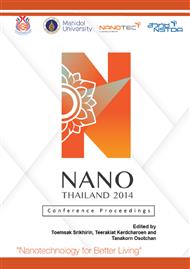p.53
p.60
p.64
p.71
p.75
p.79
p.84
p.88
p.97
Synthesis and Characterisation of ZnO Nanoparticles for Production of Antimicrobial Textiles
Abstract:
In this paper, the synthesis and characterisation of ZnO nanoparticles have been carried out for textiles applications. The ZnO nanoparticles have been synthesized by precipitation method. This technique is based on precipitation procedure by using zinc nitrate and sodium hydroxide as precursors. The scanning electron microscopy, dynamic light scattering, UV-Visible spectrophotometry and X-ray diffraction were used to characterize the particle size and morphology. The synthesized ZnO nanoparticles were spherical with the size in the range of 200-400 nm. Next step, the ZnO nanoparticles were directly applied on to the fabric using pad-dry-cure method. Finally, the antibacterial efficiency of modified fabrics was quantitatively evaluated and compared against gram-negative Escherichia coli and aerobic gram-positive Staphylococcus aureus according to AATCC 147. The results showed that the modified fabric demonstrated significant antibacterial activity against Escherichia coli and Staphylococcus aureus. These results suggest that synthesized ZnO nanoparticles could be used effectively for textiles applications.
Info:
Periodical:
Pages:
75-78
Citation:
Online since:
December 2015
Keywords:
Price:
Сopyright:
© 2016 Trans Tech Publications Ltd. All Rights Reserved
Share:
Citation:


